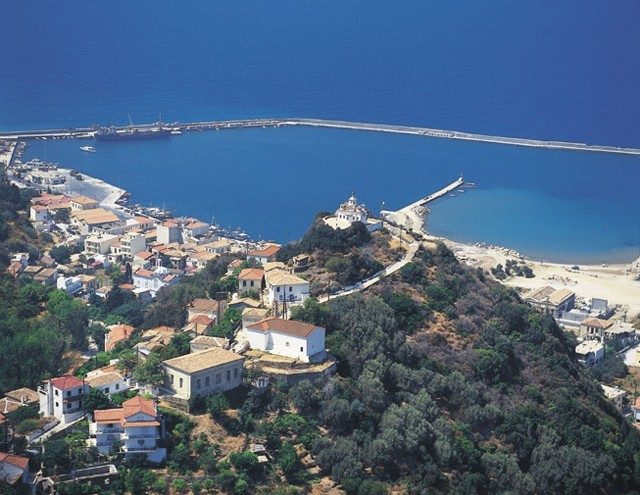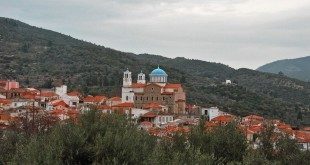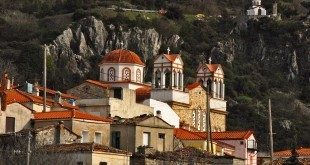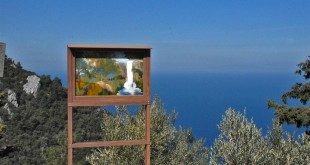The name Karlovassi originates from the two Turkish words Karli ovasi which mean snow-covered plain.The Turks called this area such because it was full of trees which became white when it snowed and resembled a snow-covered plain.
Karlovassi (or the Karlovassies) is made up of four districts which are: Neo Karlovassi, Messeo Karlovassi, Paleo Karlovassi and Limani. Neo Karlovassi which was previously called Neochori is built in an area where in ancient times there must have been a city of great prosperity. This is proven by the walls and sculptured marbles which have been found there.
The first inhabitants of Karlovassi, apart from the ancestors of the Samians who had immigrated to Chios after the Fall of Constantinople, were from Peloponnesus, Ikaria, Naxos, Crete, Evia and other islands. This explains why an icon of “Panagia tis Anapliotissas”, which was brought over from Nafplio, is found in the church Agios Dimitrios.
There are also the neighbourhoods of “Karioteika” and “Axologi” whose names bring to mind the first immigrants from Ikaria and Naxos, who settled here. These first inhabitants of Karlovassi built their homes in a forest called 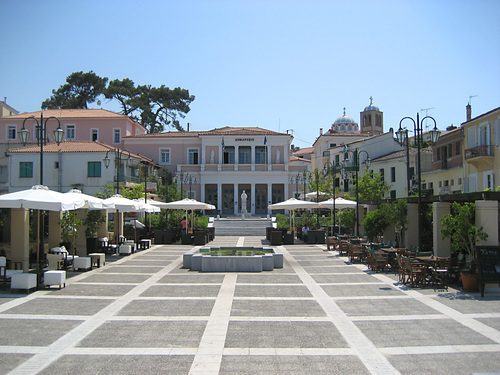 Alonaki so as not to be seen by seafarers. To the northwest of the town the monastery of Profitis Ilias is built on a densely grown plateau.
Alonaki so as not to be seen by seafarers. To the northwest of the town the monastery of Profitis Ilias is built on a densely grown plateau.
At a short distance from Neo Karlovassi is Messeo Karlovassi, which is also called Kalivia (cabins) because the first settlers in Messeo initially built cabins, that they later converted into homes. Messeo is separated from Neo Karlovassi by a torrent (known as Karlovassitiko Rema or Kerkitio in ancient times). According to past reports, the initial village was located towards the eastern side of the church Agios Athanasios, where there was most likely a village before the desertion of the island. This village extended from the church Agios Athanasios to the coast and beyond the church Osia Pelagia, where the icon bears an inscription that states the date of construction as the year 1470. According to legend, the village, which was built after the re-habitation of Samos, had two perishes: The parish of Agios Athanasios, previously mentioned, and the parish of Agia Marina.
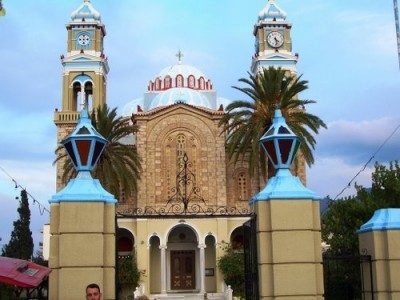 West of Messeo, at a short distance, is Paleo Karlovassi. It is built on the mountain. A gorge, through which a torrent flows, divides the village into two neighbourhoods. The one to the west is called Galatas while the one to the east is called Akamatra. As its name reveals (paleo means old), this is the oldest of the three Karlovassies. It was built on the site of Palea Vrisi by Peloponnesians. In the past Paleo Karlovassi was regarded to be among the most beautiful and prosperous villages of the island. Finally Limani (the port) of Karlovassi extends along the coast and as a work began to be constructed on the site of Skinos on the 8th of September, 1871. Its construction continued until 1903 and the funding of the work came mainly from the taxation of the goods that were imported and exported as well as from tariffs imposed on ships and individual contributions.
West of Messeo, at a short distance, is Paleo Karlovassi. It is built on the mountain. A gorge, through which a torrent flows, divides the village into two neighbourhoods. The one to the west is called Galatas while the one to the east is called Akamatra. As its name reveals (paleo means old), this is the oldest of the three Karlovassies. It was built on the site of Palea Vrisi by Peloponnesians. In the past Paleo Karlovassi was regarded to be among the most beautiful and prosperous villages of the island. Finally Limani (the port) of Karlovassi extends along the coast and as a work began to be constructed on the site of Skinos on the 8th of September, 1871. Its construction continued until 1903 and the funding of the work came mainly from the taxation of the goods that were imported and exported as well as from tariffs imposed on ships and individual contributions.
(The information has been obtained from the word “SAMIAKA” by E. Stamatiadis.)
 iSamos.gr Η ενημερωτική σελίδα της Σάμου! Εξερευνήστε τη Σάμο, τις παραλίες της, τη φύση της, τις ομορφιές της. Διαβάστε την ιστορία της Σάμου
iSamos.gr Η ενημερωτική σελίδα της Σάμου! Εξερευνήστε τη Σάμο, τις παραλίες της, τη φύση της, τις ομορφιές της. Διαβάστε την ιστορία της Σάμου

